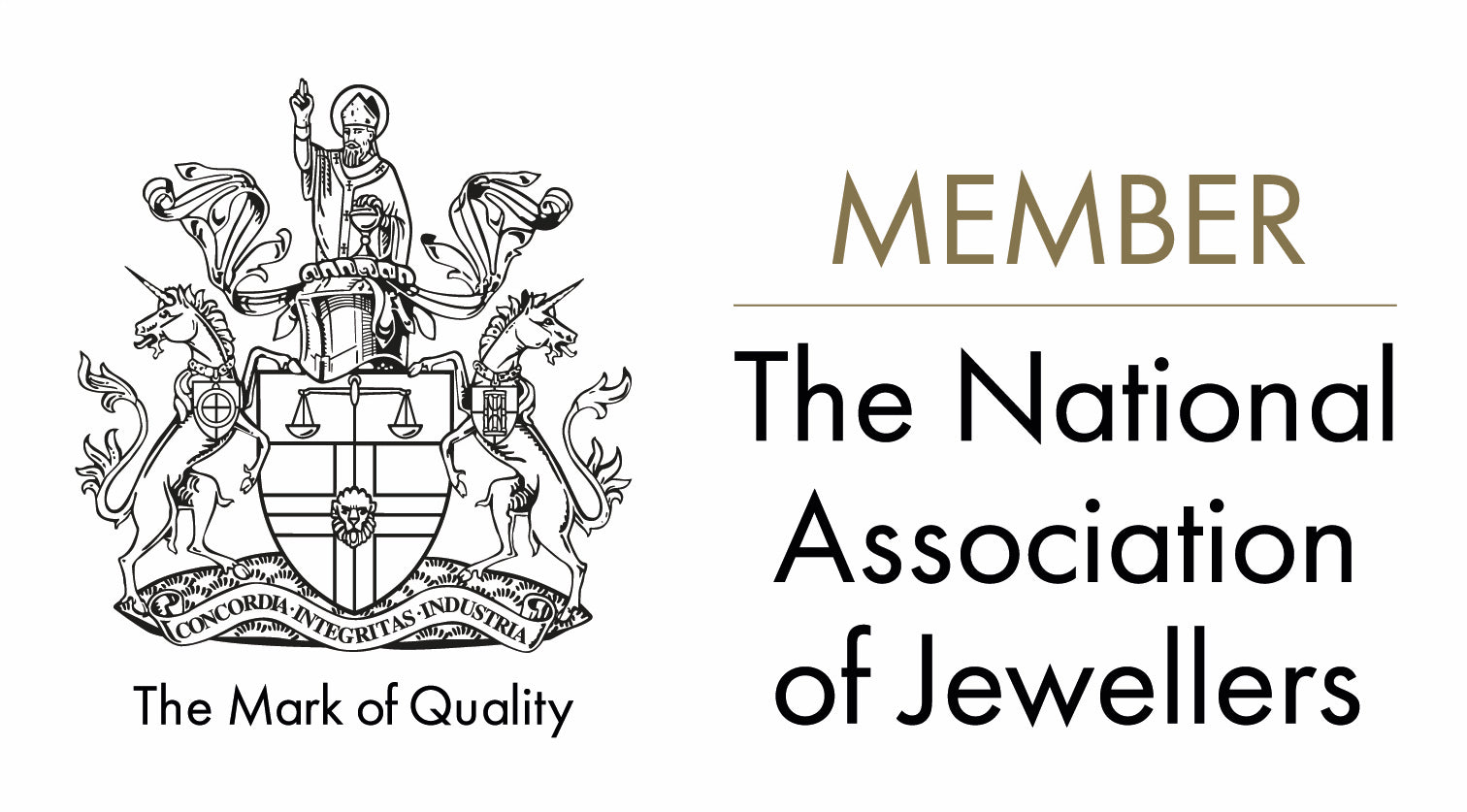Buyers Guide to Georgian Jewellery

It was a time of great social change in Britain, encapsulating many great advancements, including the abolition of slavery, the advent of rail travel and the recognition of the United States as an independent nation. It was also a time of great unrest for Britain’s neighbours, with the French Revolution and the subsequent “Age of Enlightenment”. The pressures and passions of these turbulent times gave rise to a rich and beautiful culture that is reflected in the prevalent jewellery styles of the era.
Georgian Gold

All of the gold used by Georgian goldsmiths was 18ct or higher – lower carat weights were not used until the Victorian era, when lower cost, stronger alloys became prevalent.
Although it is more valuable, 18ct gold is a good deal softer than the lower grades of gold, which made all of the pieces produced intrinsically more valuable than antiques from a later era. Unfortunately the relative fragility of this material means that Georgian pieces were more susceptible to the rigours of time, and fewer pieces survived intact to the modern day.
Georgian jewellery also predates the mass production techniques that came with the increasing industrialisation of the Victorian era. One of the most influential was the rolling mill which allowed jewellers to create metal sheets of uniform thickness without . With Georgian jewellery every piece of metal had to be hand-hammered to size. Because every piece of Georgian jewellery was hand-crafted a great deal of time was lavished on its construction.
Georgian Silver

Silversmiths were in high demand during this period, creating a dazzling array of silverware in a variety of different styles. Early Georgian tableware and cutlery was relatively simple and practical, but this changed with the introduction of much more elaborate Rococo pieces. This late baroque style was brought to England by Huguenots, French protestants who fled their homeland to escape religious persecution by the French Catholic government of the day.
These elaborate styles heavily influenced the manner in which Georgian jewellery developed, with simpler forms giving way to ever increasing complexity which required true mastery of the jewellers art.
The comparative scarcity of gold meant that older, less fashionable pieces were often melted down to create more desirable items. This conservation of materials was less necessary with the silver, as it was more readily available, consequently a larger number of Georgian silver pieces have survived into the modern age.
Pinchbeck

In the early 1700s a renowned clockmaker named Christopher Pinchbeck created an alloy of zinc and copper which bore a remarkable similarity to gold, and came to bear his name.
Pinchbeck was not intended to deceive people into mistaking it for gold, but to act as a substitute for those not able to afford 18ct gold, as this was the only gold alloy available at the time. The lower value also meant that it was safer to wear pinchbeck jewellery when travelling, or in situations where theft was a possibility.
Unfortunately during the years following the development of the first pinchbeck many unscrupulous individuals did try to pass it off as gold, which led to the material being viewed as inherently duplicitous. Pinchbeck became a term associated with chicanery and charlatanry, which did a great disservice to the deeply principled craftsmen who pioneered its use.
Today genuine pinchbeck jewellery is highly valued and collectible in its own right, particularly pieces which come from the material’s early use in the Georgian period.
You can view our collection of pinchbeck pieces here.
Paste Jewellery

With demand for gemstones outpacing supply many Georgian jewellers became extremely adept at the construction of paste stones, a heavy flint glass that simulated the fire and lustre of gemstones. The technique of crafting these stones predates the Georgian period by many years, but was extremely prevalent at this time.
You can read more about paste jewellery here.
Georgian Design

This period saw the development of candles which could burn brighter and for a longer time, allowing social engagements to extend further into the night. This led to new styles of evening and day jewellery.
Day jewellery often contained bright, colourful gemstones such as topaz, garnet, emerald and ruby, whilst diamonds were overwhelmingly popular in evening jewellery. Ostentatious wealth and excess were prevalent trends in the fashion of the day, with multiple pieces being worn at any one time, creating a dazzling array of precious metals and gemstones.
Closed Gallery and Foil Backed Jewellery

In more modern times gemstones are typically set in open galleries, which allow light to flow through the piece to increase the scintillation of the gems. Georgian pieces predate this trend, and closed back galleries were the norm. The softer, more pure gold used in this era meant that the open-worked, slimmer forms of later eras would have compromised the pieces’ durability, so alternative methods were employed to increase the vibrance of diamonds, or deepen the colour of other cardinal gems. The most common of which was foil backing.
With this technique an extremely thin sheet of metal is carefully wrapped around the back of the gemstone and concealed within the setting. The metal used varied depending on the intended effect, and was dictated very much by the effect that the jeweller wished to achieve.
Modern jewellers typically eschew foil backing, as the greater abundance of many gemstones in present day, coupled with the mathematical precision that can be achieved by machine-led cutting processes, have meant that there are simpler methods to achieve a similar effect.
In the years between the Georgian era and this foil backing was used by unscrupulous jewellers to create illusory colouration in gemstones so that a less valuable stone could be sold as a more valuable one.
Workmanship, Rarity and Value

Georgian jewellers were masters of their trade, employing a huge variety of complex techniques to produce each piece. Before the advent of mass production each hand-made piece was a unique work of art which represented a substantial investment of time and precious resources. Mistakes could be extremely costly, and the techniques took years to fully master. This high quality workmanship is one of the key appeals of the era’s jewellery, but it does mean that less pieces were produced than in later periods.
The most fragile of these beautiful pieces have been lost to time, as the wear and tear of ages has taken its toll. More upsetting is the fact that many items of Georgian jewellery whose value was far greater than the sum of its parts have not been identified, and are simply melted down for their component parts, whose value is substantially lower.
In some cases the original gemstones, links or metalwork motifs have been salvaged from badly damaged original pieces in a manner than preserves some of their original beauty. Stones may be reset in more modern galleries which pay tribute to the techniques of the Georgian era, or repurposed into different forms that are more in keeping with modern fashion trends. For example, an antique necklace of old cut diamonds may be disassembled and reimagined as multiple sets of earrings with the simple addition of hooks or fittings.

Georgian jewellery often commands a higher price than pieces from subsequent eras due to its individuality and relative fragility. Although attempts have been made in the modern age to preserve and retain surviving pieces this conservation of history follows almost two centuries where such concerns were less common.
Although Georgian jewellery may be more expensive to acquire it is more likely to appreciate in value than pieces from other periods due to its rarity and historical context.
Georgian Trends
Georgian fashion favoured extravagance, and this tribute to abundance and overt excess can be seen across a great many pieces. With each piece taking such a long time, and such an investment to produce there was no call for simpler designs. The minimalism of the 1950s was still centuries away, and Georgian pieces are often characterised by elaborate engravings, intricate metalwork and inventive combinations of gems were common, but there were also types of jewellery which were more popular in this era.
Chains were particularly valued, and jewellers created a staggering array of intricate link patterns, some of which are incredibly elaborate – a fact that is all the more impressive given that every component was hand forged and assembled. Overly long chains which could be wrapped multiple times around the neck were very much in vogue. These “Guard Chains” could be worn in many different ways, and often served a practical purpose, holding items such as scissors, keys, fobs or eyeglasses.

Mourning Rings were also extremely prevalent in the Georgian era. High mortality rates meant that death was an integral part of the lives of even the richest and most powerful, and the dead were often memorialised in jewellery.

These pieces differed from Memento Mori pieces, which translates as “remember you will die”, a largely affirmative message which encouraged one to seize the gift of life by reminding the wearer that it would end. Mourning jewellery was instead a tribute to a single lost loved one, and often contained locks of hair from that person. In some cases the hair was intricately woven into bracelets, whilst other pieces contained sections which could be opened to hold the lock within.

At Laurelle Antique Jewellery we have spent years developing the necessary expertise to identify, acquire and present the finest Georgian jewellery in the United Kingdom. To view our full collection of Georgian pieces click here. You can also find our collection on fine Georgian Engagement rings here.
Click the links below to learn more about the Victorian, Edwardian and Art Deco periods.



